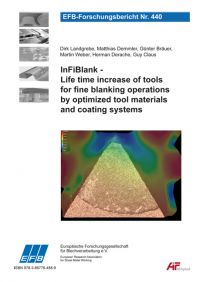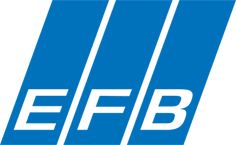InFiBlank - Life time increase of tools for fine blanking operations by optimized tool materials and coating systems

(Verlängerung der Werkzeugstandzeiten beim Feinschneiden durch optimierte Werkstoffe und Beschichtungssysteme)
Verfasser:
Prof. Dr.-Ing. Dirk Landgrebe, Dipl.-Ing. Matthias Demmler, Fraunhofer-Institut für Werkzeugmaschinen und Umformtechnik Chemnitz - Prof. Dr. Günter Bräuer, Dipl.-Ing. Martin Weber, Fraunhofer Institut für Schicht- und Oberflächentechnik Braunschweig - Herman Derache, Guy Claus, Sirris -The Collective Center of the Belgian technological industry Gent
90 Seiten - 64,00 EUR (sw, 67 teils farbige Abb., 5 Tab.)
ISBN 978-3-86776-488-9
Summary
In order to improve the lifetime of blanking tools, the application of high quality steel, heat treatment and coatings has become an interesting issue for many European companies dealing with stamping, punching and blanking operations. Important trends such as longer life time, higher accuracy and higher complexity of the products are challenging and require more special materials and techniques.
The technological solutions to improve the existing processes are not obvious because of the amount of possibilities in available materials, heat and surface treatments for the envisaged industrial processes and applications. An in-depth research to understand the manufacturing processes with the consequence of an increased performance and lifetime of the tools as well as the opportunity of further optimization was the main goal of this project.
However, the ever increasing production rate and the use of high strength steel sheet can induce problems in the wear and fracture behavior of blanking tools with low lifetimes as a consequence. This project studied the tribological synergy of the substrate-heat treatment-surface relationship and their influence on life-time in heavy load conditions.
The project shows some specials regarding the conventional tool making. Many influences in the mechanical treatment of different tool materials can support the live time or can lead to very bad cutting results, that means for example you have loose particles or bad polished and compacted surfaces.
A preliminary study was performed on the cutting edges of special designed triangular punches made of several high alloyed steels which were heat treated in a conventional way and by deep cryogenic treatment after quenching. The influence of additional plasmanitriding treatments and coatings were investigated. After the research some demonstration tools were tested in industrial conditions to show the feasibility of certain selected combinations.
From results of the preliminary study it can be concluded that all the selected steel sub-strates performed well during blanking operations. The best results were found with the Vanadis 4e and 23 steel. A special coating could improve the adhesive wear of the refer-ence steel 1.2379. In case of the PM steels the use of a coating is optional. Furthermore DCT treatment could improve the flaking and wear behaviour in both the lab scale and industrial tests. The surface preparation after EDM is found to have an important positive influence on the wear especially when the surface is blast and polished. The industrial blanking tests confirm the positive contribution of DCT on several sheet materials.
The goals of the project were achieved.
The project "InFiBlank - Life time increase of tools for fine blanking operations by optimized tool materials and coating systems" Ref.-No. AiF 102EBG was financed and supervised by the EFB. In the scope of the CORNET - European Research Programme "InFiBlank" was funded by the German Federal Ministry for Economic Affairs and Energy via the Federation of Industrial Research Associations. The report is published as EFB-Forschungsbericht Nr. 440.
Zusammenfassung
InFiBlank - Verlängerung der Werkzeugstandzeiten beim Feinschneiden durch optimierte Werkstoffe und Beschichtungssystemen
Die Standmenge von Schneidwerkzeugen wird maßgeblich von den Verschleißerscheinungen in den mit dem Werkstück in Kontakt tretenden Werkzeugbereichen beeinflusst. In Abhängigkeit von den Prozessparametern, insbesondere den Werkstück- und Werkzeugeigenschaften (Festigkeit, Geometrie, Adhäsionsneigung, etc.) treten unterschiedliche Verschleißerscheinungen auf, denen in unterschiedlicher Weise begegnet werden muss.
Beispielsweise muss Ausbrüchen an der Schneidkante durch eine Optimierung des Werkzeugwerkstoffes begegnet werden, während der Adhäsion von Werkstückwerkstoff durch eine Beschichtung oder eine angepassten Oberflächentopografie entgegengewirkt werden kann. Es wird daher eine Vorgehensweise vorgeschlagen, die auf der eingehenden Verschleißuntersuchung der zu optimierenden Werkzeuge basiert, aus der anschließend Behandlungsempfehlungen abgeleitet werden.
Die Tieftemperaturbehandlung erfolgt meistens nach dem Härten und vor dem Anlassen, in einigen Fällen aber auch erst danach. Bei der Tieftemperaturbehandlung werden zwei Temperaturbereiche unterschieden. Bei -70 bis -120°C kommt es zur Umwandlung von Restaustenit, die mit einer Härtesteigerung verbunden sein kann. Berichtet wird auch von einer höheren Formbeständigkeit der behandelten Stähle.
Beim sogenannten Deep Cryogenic Treatment (DCT) im Bereich von -135 bis -196°C kommt es neben den genannten Effekten bei der konventionellen Tieftemperaturbehandlung zur Bildung feinerer Karbidkeime sowie einer Zunahme des Karbidvolumens. Beobachtet wurde in einigen Fällen eine höhere Verschleißbeständigkeit. Die Behandlungsdauer beträgt meist 24 Stunden, kann aber durch eine zyklische Behandlung verkürzt werden.
Um das Potenzial einer DCT-Behandlung zur Optimierung von Schneidwerkzeugen zu untersuchen, wurden vergleichende Schneidversuche mit und ohne DCT-Behandlung im Labormaßstab mit verschiedenen Werkzeugstählen durchgeführt und in der industrieellen Anwendung verifiziert.
In den Industrieversuchen konnte ein positiver Effekt sowohl der Tieftemperaturbehandlung bei -80°C als auch der DCT-Behandlung für verschiedene Werkstoffe nachgewiesen werden.
Beim Feinschneiden von S700MC (Blechdicke: s = 4,5 mm) wurden mit beiden Varianten, abhängig vom Werkzeugwerkstoff, Standzeiterhöhungen von bis zu 100% erzielt.
Beim Schneiden von hochfestem Edelstahl (1200 N/mm², s = 1,5 mm) konnte bereits durch den Wechsel des Werkzeugwerkstoffes die durchschnittliche Standmenge um 30% erhöht werden. Eine zusätzliche DCT-Behandlung erbrachte eine weitere Verbesserung um 100%. Für einzelne Werkstoffe war auch mit einer Tieftemperaturbehandlung bei -80°C eine signifikante Standmengenerhöhung gegenüber dem Referenzwerkstoff möglich.
Die Ziele des Projektes wurden erreicht.
Table of Contents
1 Summary
Zusammenfassung
Symbols
Figures and Tables
Figures
Tables
2 Scientific and technical approach
3 Research objective and problem solution
4 Results
4.1 WP1 Characterization of the fine-blanking process
4.1.1 WP1.1 Requirements for fine blanking of high strength steel, stainless steel
4.1.2 WP1.2 Definition of geometries for lab scale and industrial tests / material definition
4.1.3 WP1.3 Definition of wear characterisation tests / component quality determination
4.2 WP2 Optimization of the tool material
4.2.1 WP2.2 Material hardening for basic performance
4.2.2 WP2.3 Material hardening for optimal performance
4.3 WP3 Coating development for fine blanking tools.
4.3.1 WP3.1 Coating of reference samples
4.3.2 WP3.2 Determination of coating properties on reference samples
4.3.3 WP3.3 Coating of test and production tools
4.4 WP4 Cutting tests on a laboratory scale
4.4.1 WP 4.1 Manufacturing of blanking tools for lab scale tests
4.4.2 WP 4.2 Experimental tool life studies / state of the art tests
WP 4.3 Experiments on test geometries to improve tool life by DCT
4.4.3 WP 4.3 Assement of the cutting edge / Evaluation of the cut part
4.5 WP5 Cutting tests under production conditions
4.6 WP6 Evaluation and systematization of the experimental results, final report
5 Results
5.1 Use for the SMEs, economic calculation
6 References

